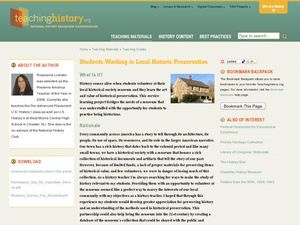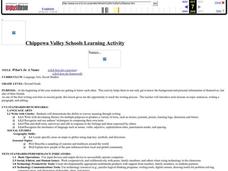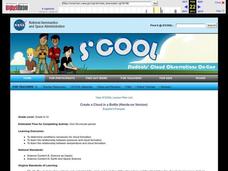Curated OER
Making Clouds: Aerosol-Cloud Interactions in a Beaker
Students observe a teacher demo on how clouds form. In this earth science lesson, students discover how cloudiness affects relative humidity. They explain the scattering of light by clouds.
Curated OER
Welcome To Program A Simple Program in C
Young scholars are introduced to the language in C programming. In groups, they determine the correct function to be used and practice running the program to achieve the desired results. They end the lesson by programming more difficult...
Curated OER
Earth and Space Science: Exploring Earthquakes
Students explore earthquakes. In this earthquake instructional activity, students research earthquakes and identify where they take place. Students use map skills to track down earthquake locations. There are internet sites suggested in...
Curated OER
What's "In" There: A Study of the Inner Planets - Mercury, Venus, Earth, and Mars
First graders identify and explore the four inner planets. In this planet science lesson, 1st graders watch a PowerPoint about the planets. Students read the book Our Solar System and discuss the inner planets. Students create a book...
Curated OER
Glow in the Dark Stars and Planets
Learners view a "night sky" made from glow in the dark stars. They discuss stars, planets, the sun, and constellations.
Curated OER
Where in the World is Carbon Dixoide?
Students conduct experiments designed to detect the presence of CO2 by using a BTB that changes color (blue to yellow) in the presence of CO2. First, students experiment with the CO2 from combining vinegar and baking soda. In part two,...
Curated OER
Students Working in Local Historic Preservation
Students develop an appreciation of history as they volunteer their time in historical museums. In this historical perspectives lesson plan, students work with valuable local documents as they aid the staff of selected local historical...
Curated OER
Immigration in Canada and in the European Union
Twelfth graders explore immigration policies. In this immigration lesson, 12th graders discuss the implications of immigration as they read polices for Canadian and European Union immigration. Students then draft their own immigration...
Curated OER
The Scientist in Me
Students make a poster. In this scientist lesson, students define the term scientist, draw pictures of themselves as scientists, and write about what they would study as a scientist.
Curated OER
Hunting for galaxies in the Hubble Deep Field
Learners examine Hubble Deep Field images. In this galaxy classification lesson, students research galaxy classification. Learners view and classify Hubble Deep field images of galaxies.
Curated OER
Exercise in Perspective
In this exercise in perspectives, students are required to analyze a topic by completing six different activities. Students can work in groups, pairs or independently to complete the activity.
Curated OER
Patterns Across Cultures: The Fibonacci Sequence in Visual Art
Students study the origin of the Fibonacci Sequence. In this investigative instructional activity students identify works of art where Golden Spiral or Ratio appear.
Curated OER
Character Traits in Gingerbread Baby #5
Learners are read the story "Gingerbread Baby". They draw or download the characters and cut them out. They create character profiles for each character based on how they acted in the book. They act out a scene from the story as well.
Curated OER
Demonstrating Erosion in Action
Young scholars easure and record volume of water, then measure and record mass of soil. They explain the effects of the following in controlling erosion: Contouring, cover crop, strip cropping, reforestation, inter-seeding.
Curated OER
Count in Steps of One
In this counting activity, students count the 5 lollies on the page and write the number 5 in the space at the bottom of the activity. There is a concepts section on the second page for teachers to read and learn about teaching children...
Curated OER
What's In A Name
Second graders write a paragraph about their findings on what their name represents. In this writing lesson plan, 2nd graders will research their name and why they were named that. They will draw a picture that represents them along with...
Curated OER
Create a Cloud in a Jar (Hands-on Version)
High schoolers examine the conditions necessary for cloud formation. For this clouds lesson students complete an activity that shows them atmospheric pressure.
Curated OER
Create a Cloud in a Bottle
Students investigate the conditions needed for cloud formation and explore how pressure and temperature effect cloud formation. In this atmospheric pressure lesson students complete a lab on cloud formation.
Curated OER
The Ghost In The Graveyard
Young scholars practice chasing and fleeing skills by playing the game Ghost in the Graveyard.
Curated OER
Cultural Diversity In The Classroom
Students engage in a lesson that supports the fact that Asian people are part of the educational culture in schools. The lesson includes background information for the teacher. With the completion of the unit students develop a personal...
Curated OER
Partnership in Science Education
Students compare two regions of the world, their own and one many miles away. They explore and compare these two places and prepare a report that gives a complete comparison and description of the two regions. They collaborate in...
Curated OER
What is in Soil?
Fourth graders identify and examine the components that make up soil. Individually, they use a magnifying glass to identify the organic and inorganic material in their soil sample. To end the lesson, they record the differences in the...
Curated OER
Exchange of Goods and Ideas in the Ancient Mediterranean
Ninth graders begin the lesson by discussing and locating the trade routes in the Mediterranean. Using pieces of pottery and coins, they discuss how it shows the culture of an area and create a chart showing the value of the coins. ...
Curated OER
What's in the News?
In this analysing articles worksheet, students read two newspaper articles about the issue of radon and answer six questions that allow students to reflect on how the articles were written and what is left unknown to the readers.

























